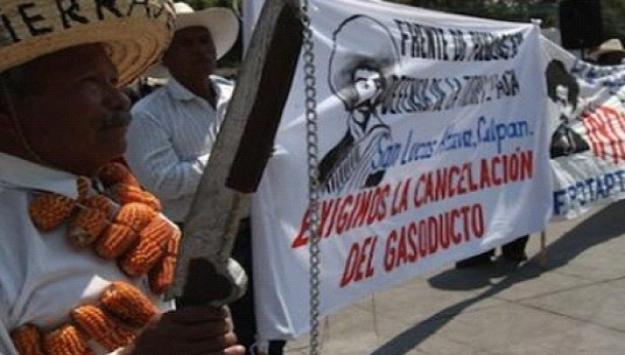Mexico: Politics, Earthquakes, and NAFTA
Mexican President Enrique Peña Nieto
In Mexico, earthquakes and politics are closely intertwined. The country’s 1985 earthquake (centred in Mexico City with a magnitude of 8.1) left 10,000 dead and 30,000 injured. It proved to be a defining political moment in the country’s politics. The failure of the government of President Miguel Hurtado to respond to the devastation, including his refusal of outside assistance, prompted widespread grassroots social mobilization. Spontaneously, thousands of assistance groups organized themselves to come to the aid of earthquake victims. A great many of these newly formed civil society organizations, and their opposition to the government, had been fueled by its callousness in the face of the earthquake tragedy, and formed the bases of a new political front (the National Democratic Front) that challenged the ruling party (the Institutionalized Revolutionary Party, PRI) in the 1988 presidential election. It is widely believed that the PRI presidential candidate lost that election although the party managed to hang onto power. Faced with clear evidence of impending defeat, the government closed down the country’s computerized voting system, rejigged the vote tally, and declared victory. But Mexico’s transition to electoral democracy had begun. The use of electoral fraud gradually diminished as it became important to convince the country’s new NAFTA partners that Mexico was a worthy trade partner. By 1997, the ruling party had lost control of Congress and by 2000 the presidency.
The Earthquakes: The Final Nail in the PRI Coffin
PRI president, Enrique Peña Nieto, has held power since 2012. He is deeply unpopular, with a dismal 12 percent approval rating. He has presided over low economic growth, numerous corruption scandals, the massacre of 43 students in the state of Guerrero for which the government is deemed implicated, and (perhaps worst of all) is perceived as weak in the face of President Trump’s numerous threats. Peña Nieto does not need more reasons for the Mexican public to dislike him, but he now has one more.
Citizen Volunteers, Mexico City
While the death and injury toll is substantially less than in 1985, thousands remain homeless and hungry. Moreover, two of the three September 2017 quakes have impacted southern Mexico where the indigenous and poorest of the population is concentrated. The largest magnitude quake (8.1) occurred September 3rd off the coast of the southern state of Chiapas, affecting the states of Chiapas and Oaxaca the most, while on September 23rd the state of Oaxaca was the epicentre of another quake of 6.1 magnitude. At least 41 municipalities in these two states had been devastated by the September 3rd quake, affecting mostly those who are categorized as extremely poor (the poorest of the poor). Already living in extreme deprivation, the plight of these populations has become unbearable. In the poor communities of Chiapas and Oaxaca, and in Mexico City, there has been widespread grassroots mobilization to help the victims. Immediately, volunteers from all walks of life flowed into the streets to aid in rescue operations, while the presence and helpfulness of police, military, and government officials tended to be comparatively sparse.
Yet another Reason for Popular (particularly Indigenous) Opposition
Leaders of the Indigenous and Peasant Front (FICAM), an umbrella organization integrating some 800 communities and organizations across 14 states, has complained bitterly about the federal government’s inadequate response in coming to the aid of earthquake victims. In the same press conference where they voiced this complaint, leaders also demanded that the re-negotiation of the North American Free Trade Agreement secure the removal of the section in NAFTA providing for trade liberalization in the agricultural sector so that Mexico could become self-sufficient in food—a demand meant to secure protection of the country’s indigenous farming sector. Further, these leaders emphasized indigenous rejection of the country’s neoliberal economic model, in particular government plans to establish economic zones in the south of the country for the purpose to taking advantage of cheap Indigenous labor and the south’s abundant petroleum and gas resources.
FICAM Protest against Energy Reform
While the federal government’s response to the earthquakes has been far less callous that in 1985, and the death toll far less (estimated currently at about 400), the recent earthquakes are, nevertheless, fueling the already strong animosity of popular groups, particularly Indigenous ones, against the government. Furthermore, the general upsurge in social organizing occasioned by the earthquake and the perception that the government’s response has been inadequate, are likely to strengthen popular civil society opposition to the current regime. One of the central issues of the opposition has been the recent opening up of the country’s petroleum sector to foreign investment—a measure that the front-runner for the next Mexican presidency, Manuel Andrés Lopez Obrador, has promised to reverse if elected. It is important to emphasize that this measure would further disrupt the lives of the poor in southern Mexico. Meanwhile, Mexican NAFTA re-negotiators are currently seeking to secure Mexico’s incorporation into the energy chapter of the agreement in order to lock in the energy reforms meant to encourage more resource/petroleum extraction in the south. The juxtaposition of a deeply unpopular regime, NAFTA re-negotiations geared to revisions arousing popular angst, and the devastation wrought by three earthquakes, will all contribute to greater political polarization. In this political context, even if a NAFTA agreement is concluded within the next year, it is by no means secure.



